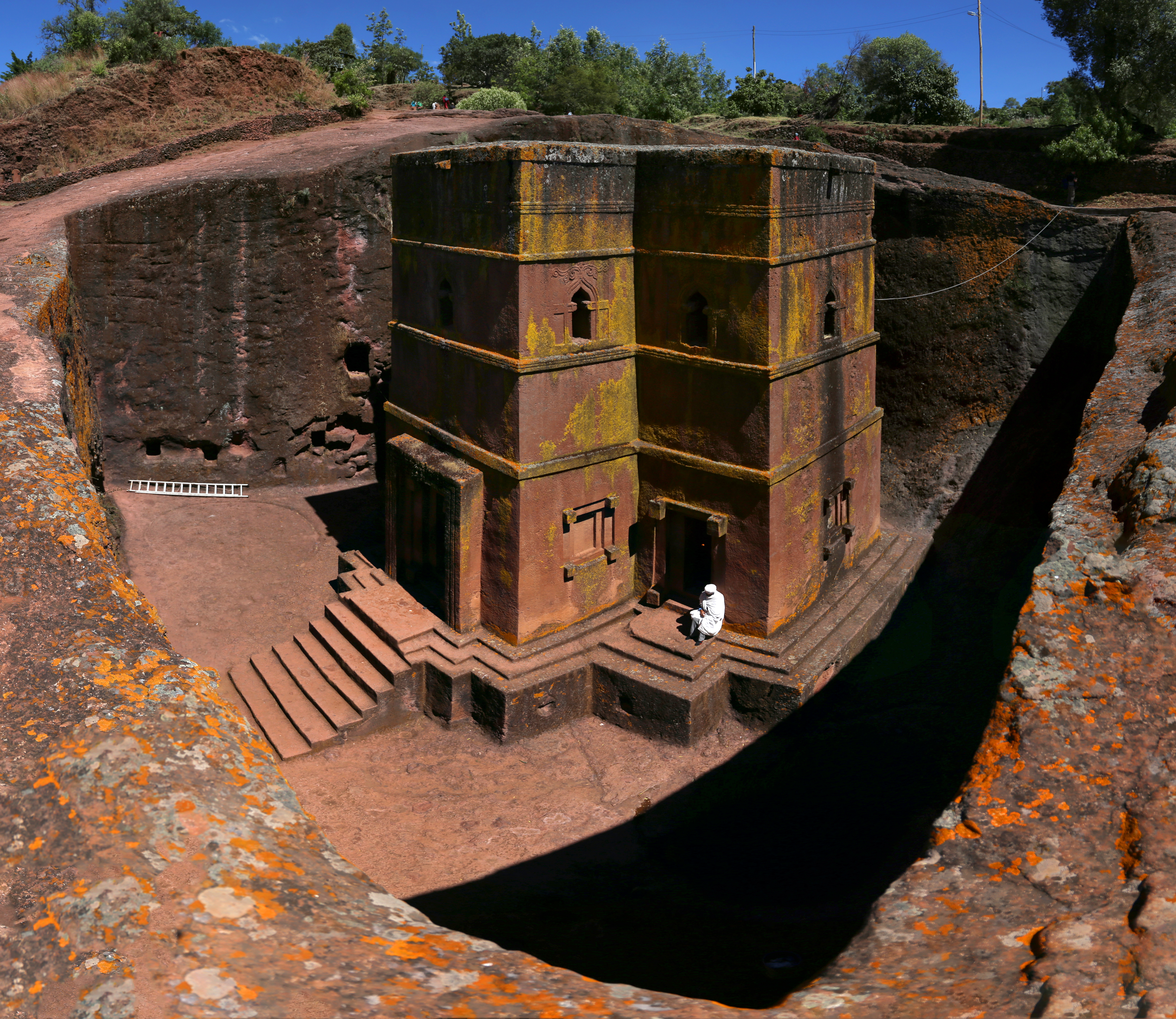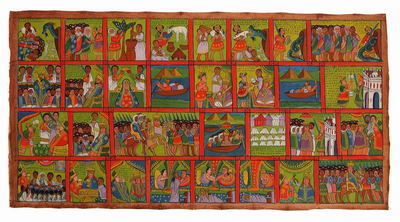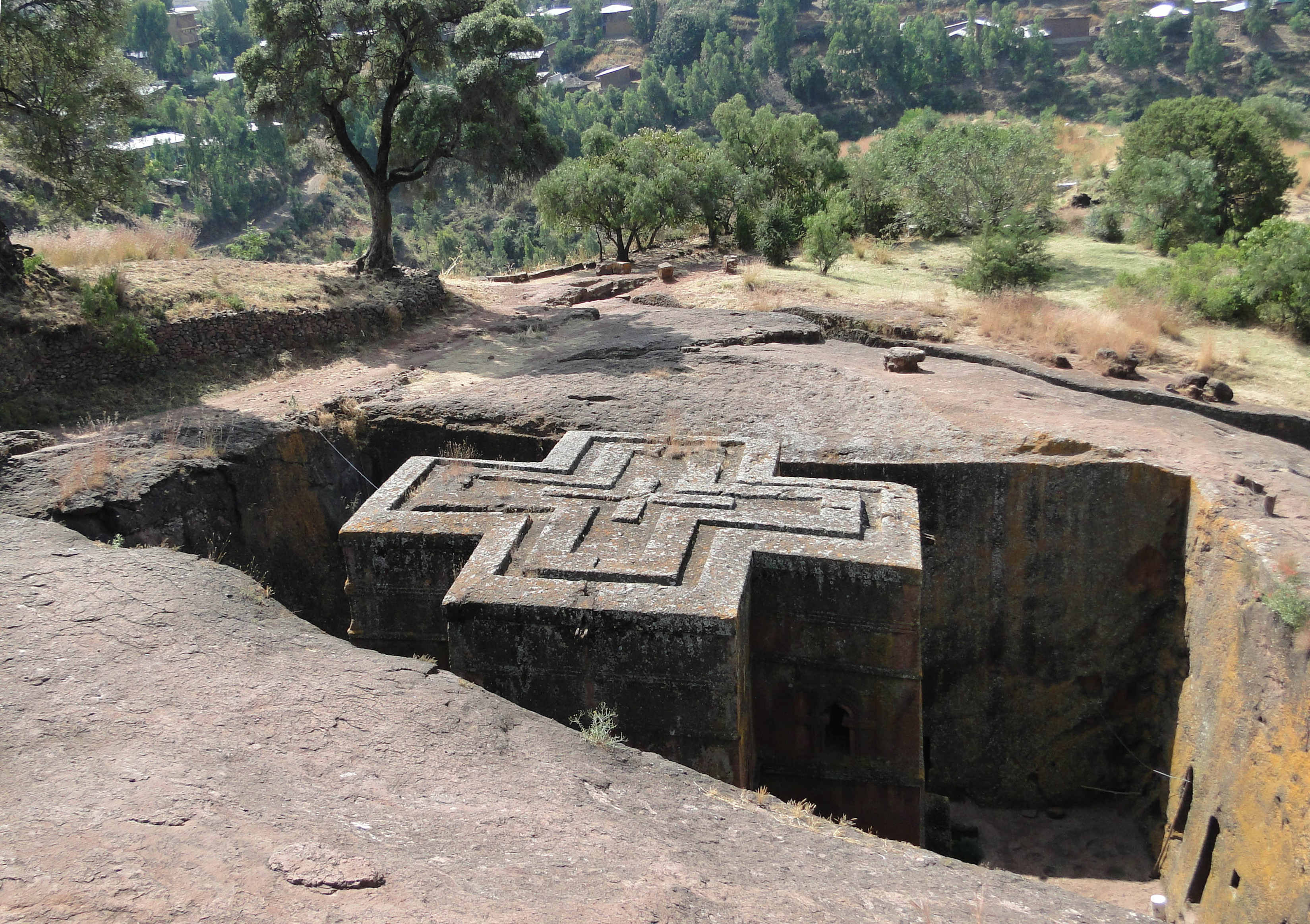|
Ethiopia In The Middle Ages
The history of Ethiopia in the Middle Ages roughly spans the period from the decline of the Kingdom of Aksum in the 7th century to the Oromo migrations beginning in the mid-16th century.Kelly, "Introduction", p. 16 Aksum had been a powerful empire during late antiquity, appearing in the Periplus of the Erythraean Sea and mentioned by Iranian prophet Mani as one of the "four great kingdoms on earth", along with the Sasanian Empire of Persia, the Roman Empire, and China's Three Kingdoms.Munro-Hay The kingdom was an integral part of the trade route between Rome and the Indian subcontinent, had substantial cultural ties to the Greco-Roman world, and was a very early adopter of Christianity under Ezana of Aksum in the mid-4th century. The use of "Ethiopia" to refer to the region dates back to the 4th century. At its height, the kingdom spanned what is now Eritrea, northern Ethiopia, eastern Sudan, Yemen and the southern part of what is now Saudi Arabia. However, by the 7th century, t ... [...More Info...] [...Related Items...] OR: [Wikipedia] [Google] [Baidu] |
Agaw People
The Agaw or Agew ( gez, አገው ''Agäw'', modern ''Agew'') are a pan-ethnic identity native to the northern highlands of Ethiopia and neighboring Eritrea. They speak the Agaw languages, which belong to the Cushitic branch of the Afroasiatic language family, and are therefore linguistically closest related to peoples speaking other Cushitic languages. The Agaw peoples in general were historically noted by travelers and outside observers to have practiced what some described as a “Hebraic religion”, though some practiced Ethiopian Orthodoxy, and many were Beta Israel Jews. A small minority have adopted Islam in the last few centuries. Thousands of Agaw Beta Israel converted to Christianity in the 19th and early 20th century (both voluntarily and forcibly), becoming the Falash Mura, though many are now returning to Judaism. History The Agaw are perhaps first mentioned in the third-century '' Monumentum Adulitanum'', an Aksumite inscription recorded by Cosmas Indicopleu ... [...More Info...] [...Related Items...] OR: [Wikipedia] [Google] [Baidu] |
Menelik I
Menelik I ( Ge'ez: ምኒልክ) was the claimed first Emperor of Ethiopia. According to Kebra Nagast, a 14th-century national epic, in the 10th century BC he is said to have inaugurated the Solomonic dynasty of Ethiopia, so named because Menelik I was the son of the biblical King Solomon of ancient Israel and of Makeda, the Queen of Sheba. Life According to the medieval Ethiopian book, the ''Kebra Nagast,'' translated into Geʽez in 1321 CE, his name was ''Bäynä Ləḥkəm'' (from ar, ابن الحكيم, , "So''n of the Wise."'')''.'' He was conceived when his father Solomon tricked his visiting mother, the Queen of Sheba, into sleeping with him. His mother raised him as a Jew in her homeland and he only traveled to Jerusalem to meet his father for the first time when he was in his twenties. While his father begged Menelik to stay and rule over Israel, Menelik told him that he wanted to return home. Thus, Solomon sent many Israelites with him, to aid him in ruling accor ... [...More Info...] [...Related Items...] OR: [Wikipedia] [Google] [Baidu] |
Queen Of Sheba
The Queen of Sheba ( he, מַלְכַּת שְׁבָא, Malkaṯ Šəḇāʾ; ar, ملكة سبأ, Malikat Sabaʾ; gez, ንግሥተ ሳባ, Nəgśətä Saba) is a figure first mentioned in the Hebrew Bible. In the original story, she brings a caravan of valuable gifts for the Israelite King Solomon. This account has undergone extensive Jewish, Islamic, Yemenite and Ethiopian elaborations, and it has become the subject of one of the most widespread and fertile cycles of legends in the Middle East. Modern historians identify Sheba with both the South Arabian kingdom of Saba in present-day Yemen and Ethiopia. The queen's existence is disputed among historians. Narratives Biblical The Queen of Sheba ( he, מַלְכַּת שְׁבָא, Malkaṯ Šəḇāʾ, in the Hebrew Bible; grc-koi, βασίλισσα Σαβά, basílissa Sabá, in the Septuagint; syr, ܡܠܟܬ ܫܒܐ; gez, ንግሥተ ሳባ, Nəgśətä Saba), whose name is not stated, came to Jerusalem " ... [...More Info...] [...Related Items...] OR: [Wikipedia] [Google] [Baidu] |
Solomon
Solomon (; , ),, ; ar, سُلَيْمَان, ', , ; el, Σολομών, ; la, Salomon also called Jedidiah (Hebrew language, Hebrew: , Modern Hebrew, Modern: , Tiberian Hebrew, Tiberian: ''Yăḏīḏăyāh'', "beloved of Yahweh, Yah"), was a monarch of ancient Israel and the son and successor of David, according to the Hebrew Bible and the Old Testament. He is described as having been the penultimate ruler of an amalgamated Kingdom of Israel (united monarchy), Israel and Judah. The hypothesized dates of Solomon's reign are 970–931 BCE. After his death, his son and successor Rehoboam would adopt harsh policy towards the northern tribes, eventually leading to the splitting of the Israelites between the Kingdom of Israel (Samaria), Kingdom of Israel in the north and the Kingdom of Judah in the south. Following the split, his Patrilineality#In the Bible, patrilineal descendants ruled over Judah alone. The Bible says Solomon built the Solomon's Temple, First Temple in Jerus ... [...More Info...] [...Related Items...] OR: [Wikipedia] [Google] [Baidu] |
National Epic
A national epic is an epic poem or a literary work of epic scope which seeks or is believed to capture and express the essence or spirit of a particular nation—not necessarily a nation state, but at least an ethnic or linguistic group with aspirations to independence or autonomy. National epics frequently recount the origin of a nation, a part of its history, or a crucial event in the development of national identity such as other national symbols. History In medieval times Homer's ''Iliad'' was taken to be based on historical facts, and the Trojan War came to be considered as seminal in the genealogies of European monarchies. Virgil's ''Aeneid'' was taken to be the Roman equivalent of the ''Iliad'', starting from the Fall of Troy and leading up to the birth of the young Roman nation. According to the then prevailing conception of history, empires were born and died in organic succession and correspondences existed between the past and the present. Geoffrey of Monmou ... [...More Info...] [...Related Items...] OR: [Wikipedia] [Google] [Baidu] |
Kebra Nagast
The Kebra Nagast, var. Kebra Negast ( gez, ክብረ ነገሥት, ), or The Glory of the Kings, is a 14th-century national epic from Ethiopia, written in Ge'ez by Nebure Id Ishaq of Axum, by the office of Abuna Abba Giyorgis and at the command of the governor of Enderta Ya'ibika Igzi'. The text, in its existing form, is at least 700 years old and although clearly legendary is considered by many Ethiopian Christians to be a historically reliable work. It is considered to hold the genealogy of the Solomonic dynasty, which followed the Ethiopian Orthodox Church. The text contains an account of how the Queen of Sheba (Queen Makeda of Ethiopia) met King Solomon and about how the Ark of the Covenant came to Ethiopia with their son Menelik I (Menyelek). It also discusses the conversion of Ethiopians from the worship of the Sun, Moon, and stars to that of the "Lord God of Israel". As the Ethiopianist Edward Ullendorff explained in the 1967 Schweich Lectures, "The ''Kebra Nagast'' ... [...More Info...] [...Related Items...] OR: [Wikipedia] [Google] [Baidu] |
Solomonic Dynasty
The Solomonic dynasty, also known as the House of Solomon, was the ruling dynasty of the Ethiopian Empire formed in the thirteenth century. Its members claim lineal descent from the biblical King Solomon and the Queen of Sheba. Tradition asserts that the queen gave birth to Menelik I after her Biblically described visit to Solomon in Jerusalem. In 1270, the Zagwe dynasty was overthrown by Yekuno Amlak, who claimed descent from Solomon and founded the Solomonic era of Ethiopia. The dynasty lasted until 1974, ended by a coup d'état and the deposition of Haile Selassie, who was a Solomonic prince through his grandmother. History The Solomonic dynasty, a bastion of Ethiopian Orthodox Christianity, came to rule Ethiopia on 10 Nehasé 1262 EC (10 August 1270 CE) when Yekuno Amlak overthrew the last ruler of the Zagwe dynasty at the Battle of Ansata. Yekuno Amlak claimed direct male line descent from the old Axumite royal house that the Zagwes had replaced on the throne. Me ... [...More Info...] [...Related Items...] OR: [Wikipedia] [Google] [Baidu] |
Yekuno Amlak
Yekuno Amlak ( Ge’ez: ይኩኖ አምላክ); throne name Tasfa Iyasus (ተስፋ ኢየሱስ; died 19 June 1285) was Emperor of Ethiopia, and the founder of the Solomonic dynasty, which lasted until 1974. He was a ruler from Bete Amhara (in parts of modern day Wollo and northern Shewa) who became the Emperor of Ethiopia following the defeat of the last Zagwe king. Rise to power Yekuno Amlak hailed from an ancient Amhara family. Much of what is known about Yekuno Amlak is documented; his letter to the Egyptian ruler serving as one of the oldest examples, along with medieval hagiographies, and to a lesser extent based on oral traditions. Yekuno Amlak was the local ruler of Geshen and Ambassel around the Lake Hayq region. where he was educated at Lake Hayq's Istifanos Monastery. Later medieval hagiographies state Saint Tekle Haymanot raised and educated him, helping him depose the last king of the Zagwe dynasty. Earlier hagiographies, however, state that it was Iyasu ... [...More Info...] [...Related Items...] OR: [Wikipedia] [Google] [Baidu] |
Lasta
Lasta (Amharic: ላስታ ''lāstā'') is a historic district in northern Ethiopia. It is the district in which Lalibela is situated, the former capital of Ethiopia during the Zagwe dynasty and home to 11 medieval rock-hewn churches. Its original name in the Middle Ages was Begwena. According to G.W.B. Huntingford, Lasta is first mentioned in the fourteenth century, although it obviously had been inhabited long before that. In the 18th century the Czech Franciscan Remedius Prutky listed Lasta as one of the 22 provinces of Ethiopia still subject to the Emperor, but singled Lasta out as one of the six he considered "large and truly deserving of the name of kingdom."J.H. Arrowsmith-Brown (trans.), ''Prutky's Travels in Ethiopia and other Countries'' with notes by Richard Pankhurst (London: Hakluyt Society, 1991), p. 131 Its neighbor to the west was Begemder Begemder ( amh, በጌምድር; also known as Gondar or Gonder, alternative name borrowed from its 20th century capital ... [...More Info...] [...Related Items...] OR: [Wikipedia] [Google] [Baidu] |
Rock-Hewn Churches, Lalibela
The eleven Rock-hewn Churches of Lalibela are monolithic churches located in the Western Ethiopian Highlands near the town of Lalibela, named after the late-12th and early-13th century King Gebre Mesqel Lalibela of the Zagwe dynasty, who commissioned the massive building project of 11 rock-hewn churches to recreate the holy city of Jerusalem in his own kingdom. The site remains in use by the Ethiopian Orthodox Christian Church to this day, and it remains an important place of pilgrimage for Ethiopian Orthodox worshipers. It took 24 years to build all the 11 rock hewn churches. History According to local tradition, Lalibela (traditionally known as Roha) was founded by an Agew family called the Zagwa or Zagwe in 1137 AD. The churches are said to have been built during the Zagwe dynasty, under the rule of King Gebre Mesqel Lalibela (r. ca. 1181–1221 AD), although it is more likely that they evolved into their current form over the course of several phases of construction and al ... [...More Info...] [...Related Items...] OR: [Wikipedia] [Google] [Baidu] |
Lalibela
Lalibela ( am, ላሊበላ) is a town in the Amhara Region of Ethiopia. Located in the Lasta district and North Wollo Zone, it is a tourist site for its famous rock-cut monolithic churches. The whole of Lalibela is a large and important site for the antiquity, medieval, and post-medieval civilization of Ethiopia. To Christians, Lalibela is one of Ethiopia's holiest cities, and a center of pilgrimage. Ethiopia was one of the earliest nations to adopt Christianity in the first half of the 4th century, and its historical roots date to the time of the Apostles. The churches themselves date from the 7th to 13th centuries, and are traditionally dated to the reign of the Zagwe (Agaw) king Gebre Mesqel Lalibela (r. ca. 1181–1221). The layout and names of the major buildings in Lalibela are widely accepted, especially by local clergy, to be a symbolic representation of Jerusalem. This has led some experts to date the current church construction to the years following the capture ... [...More Info...] [...Related Items...] OR: [Wikipedia] [Google] [Baidu] |







